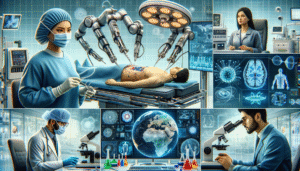
Unlocking the Secrets of the Human Brain: A Journey into the Mind
The human brain, a three-pound organ of astonishing complexity, remains one of science’s greatest mysteries. This intricate network of billions of neurons and trillions of synapses orchestrates our every thought, feeling, and action. While much remains unknown, advancements in neuroscience are continually unlocking its secrets, offering glimpses into the inner workings of consciousness, cognition, and behavior.
The Building Blocks: Neurons and Synapses
Understanding the brain begins with its fundamental units: neurons and synapses. Neurons are specialized cells that transmit information throughout the body. They communicate with each other through chemical and electrical signals across tiny gaps called synapses. This intricate communication network forms the basis of all brain activity, from simple reflexes to complex thought processes.
Brain Regions and Their Functions
The brain is divided into distinct regions, each with specialized functions. The cerebrum, the largest part of the brain, is responsible for higher-level cognitive functions such as language, memory, and reasoning. It is divided into two hemispheres, further subdivided into lobes. The frontal lobe governs executive functions, planning, and personality. The parietal lobe processes sensory information, spatial awareness, and navigation. The temporal lobe plays a crucial role in auditory processing, memory formation, and language comprehension. The occipital lobe is dedicated to visual processing. Beneath the cerebrum lies the cerebellum, essential for coordination, balance, and motor control. The brainstem, connecting the cerebrum and cerebellum to the spinal cord, regulates vital functions like breathing, heart rate, and sleep cycles.
Mapping the Brain: Modern Neuroimaging Techniques
Advances in neuroimaging technology have revolutionized our ability to study the brain in action. Electroencephalography (EEG) measures electrical activity in the brain, providing insights into sleep patterns and brainwave activity. Magnetoencephalography (MEG) detects magnetic fields produced by brain activity, offering excellent temporal resolution. Functional magnetic resonance imaging (fMRI) measures brain activity by detecting changes in blood flow, revealing which brain regions are active during specific tasks. Diffusion tensor imaging (DTI) maps the white matter tracts that connect different brain regions, providing insights into the brain’s structural connectivity.
The Enigma of Consciousness
Perhaps the most profound mystery of the human brain is consciousness – our subjective awareness of ourselves and the world around us. While the neural correlates of consciousness are being investigated, the underlying mechanisms that give rise to subjective experience remain elusive. Researchers are exploring various theories, including integrated information theory and global workspace theory, to understand how consciousness emerges from the complex interplay of brain activity.
The Power of Neuroplasticity
The brain is not a static organ. It possesses remarkable plasticity, the ability to reorganize itself throughout life in response to experiences and learning. This adaptability allows the brain to recover from injury, learn new skills, and adapt to changing environments. Neuroplasticity highlights the dynamic nature of the brain and its capacity for lifelong change.
Decoding Memory: From Short-Term to Long-Term
Memory, the ability to store and retrieve information, is another fascinating aspect of brain function. Short-term memory, also known as working memory, holds information temporarily while we are actively using it. Long-term memory, on the other hand, stores information for extended periods, from days to years. The hippocampus, a seahorse-shaped structure in the temporal lobe, plays a crucial role in consolidating memories and transferring them from short-term to long-term storage.
Language: The Gift of Communication
Language, a uniquely human capacity, enables us to communicate complex ideas and share knowledge. Specific brain regions, including Broca’s area and Wernicke’s area, are essential for language production and comprehension. Damage to these areas can result in aphasia, a language disorder that affects the ability to speak, understand, read, or write.
The Impact of Emotions
Emotions, powerful drivers of human behavior, are intricately linked to brain activity. The amygdala, an almond-shaped structure in the limbic system, plays a central role in processing emotions, particularly fear and anger. The limbic system, often referred to as the emotional brain, interacts with other brain regions to influence our thoughts, decisions, and actions.
The Future of Brain Research
The quest to understand the human brain is an ongoing journey. Advancements in neuroscience are paving the way for new treatments for neurological disorders, such as Alzheimer’s disease and Parkinson’s disease. Brain-computer interfaces hold the promise of restoring lost function and enhancing human capabilities. As we continue to explore the intricate workings of the human brain, we move closer to unraveling the mysteries of the mind and unlocking its full potential.
















